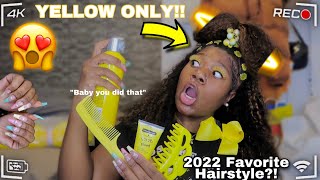4 Harmful Chemicals in Hair Care Products That'll Eventually Destroy Your Hair
Unlike homemade DIY hair treatments made from natural ingredients, many of the hair products you purchase in stores, pharmacies, or beauty salons contain harmful chemicals. When you use these products continually, there’s a chance you’ll cause temporary or permanent damage to your scalp and hair.
The first step in determining if a hairstyle you’ve been dying to try is worth taking the risk is by knowing which products will be used to achieve your new look. If the products involved contain any dangerous chemicals for your hair, perhaps it’s better to consider going for a different look altogether.
Harmful Chemicals in Hair Products

Have you ever seen a bottle of shampoo with a safety warning plastered on the front? Does your favorite hair gel have a yellow poison skeleton label on the tube? Do hair dye boxes show models with dull and dried-out tresses? Of course not!
Don’t expect hair care product manufacturers to advertise chemical hazards on their packaging materials. Nope, if you want to find out what’s really in the sweet-smelling hair and scalp products you love, you’ll have to read the small-print ingredient list.
Harmful Chemical #1 – Sodium Hydroxide
Have you ever poured a harsh liquid chemical solution into your shower or sink drain to help unclog it? You let it sit for about 15-20 minutes, and presto, your drain is clean? Guess what? The active ingredient that dissolved a thick clump of matted hair in your drainpipe is the same stuff that’s used in many chemical hair straighteners: Sodium Hydroxide, aka lye.
Lye is strong enough to melt the hair off your head if you leave it on too long or miscalculate the formulation. Even if you don’t experience this type of nightmare scenario, you’ll have to deal with incredibly dry and damaged hair. Steer clear of this chemical at all costs.
Harmful Chemical #2 – Sodium Lauryl Sulfate/Sodium Laureth Sulfate
Understandably, many people believe the more lather a shampoo produces, the better it is at cleaning hair. While it’s true that shampoos containing sodium lauryl sulfate and sodium laureth sulfate (better known as ‘sulfates’) do help to clean hair and create sudsy bubbles, they’re not necessarily doing the best job of removing dirt and grime.
These sulfates are essentially detergents that can be very harsh. Think about it, would you use laundry detergent or dish soap on your hair? Probably not.
Regular use of shampoos with sulfates can strip away your hair and scalp’s natural moisture, causing not only unhealthy hair but also a flaky, itchy scalp. Sulfates also strip color from your hair, which exacerbates the damage the dye has already caused.
Harmful Chemical #3 – Propylene Glycol
OK, so we’ve established that you would never opt to wash your hair with laundry detergent, but would you style your hair with anti-freeze? If not, then you should avoid any hair gels and conditioners that contain propylene glycol. That’s the same active ingredient used in certain industrial products such as paint, e-cigarettes, and anti-freeze.
On its own, propylene glycol is a colorless, odorless liquid with hardly any taste and the consistency of a light syrup that’s a bit thicker than water. It falls into the same chemical class as alcohol and is good at retaining moisture, which makes it a popular food and cosmetic additive.
The jury is still out on whether propylene glycol is harmful to ingest, so we won’t comment on that aspect of it. We can say this: any product with chemical properties similar to alcohol can be detrimental to the hair and scalp. Eventually, they’ll cause damage and dryness, which will lead to split ends over time. Best to avoid when you can.
Harmful Chemical #4 – Para-Phenylenediamine (PPD)
Have you ever noticed when you apply semi-permanent and permanent hair dyes at home or in a salon, your scalp and hair get warm and tingly under the plastic cap? That’s because a powerful chemical reaction is taking place: the hair cuticle is opening to allow the dye to penetrate the cortex of the hair.
We won’t waste time suggesting that you don’t dye your hair at all; we know you won’t listen to that advice. So instead, we’ll just remind you that if you’re prone to scalp sensitivity or allergic reactions, be careful when using hair dyes that contain PPD (most of them do). If you’re not sure you have sensitivities, then do a patch test first.
And don’t be fooled; PPD is also found in many high-end salon products, so definitely ask your stylist if it’s in the dye he’s planning to use on your hair.
Everything in Moderation

You might find it hard to avoid using some hair products that contain these harmful chemical ingredients. But now that you’re aware of the dangers, you can keep on the lookout for new products that don’t include them. At the very least, limit their use and give your hair a break now and then. Here are some guidelines:
- Learn to love your natural hair and avoid chemical hair straighteners. If you don’t, be prepared to cut and trim the damaged hair eventually.
- Use sulfate-free shampoos as much as possible. If you must use a shampoo with sulfates, then try to limit it to once a month.
- Find hair gels, mousses, and creams that don’t include propylene glycol. Take a little extra time to read the labels until you find one that appeals to you. Products containing isopropyl myristate are a safer alternative.
- Dye your hair every 8-12 weeks instead of every 4-6 weeks. During the transition period, use touch-up sprays, hair clips, scarves, headbands, etc.
Related Posts

A Quick Guide to Baby Hairs

10 Best Blow Dryer Diffusers for Curly Hair + Tips for the Best Results

Collagen for Hair – Benefits & How to Use

Chlorine for Hair: Dangerous Effects & How to Protect
Add Your Comment
Cancel reply




